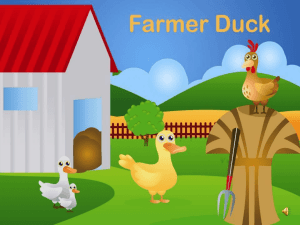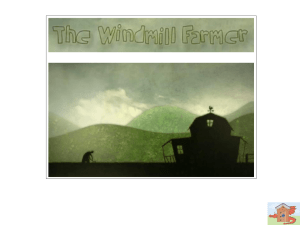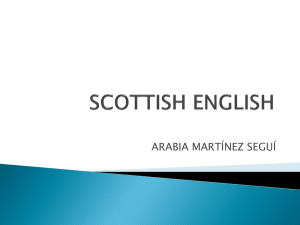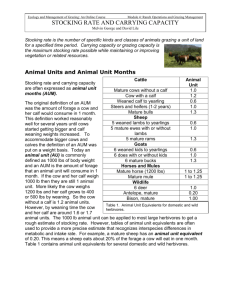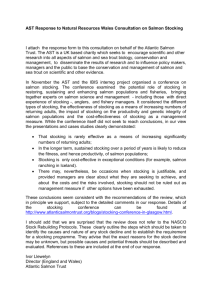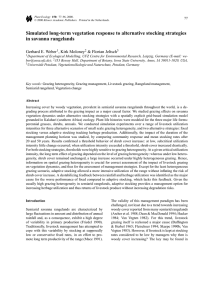Open - The Scottish Government
advertisement
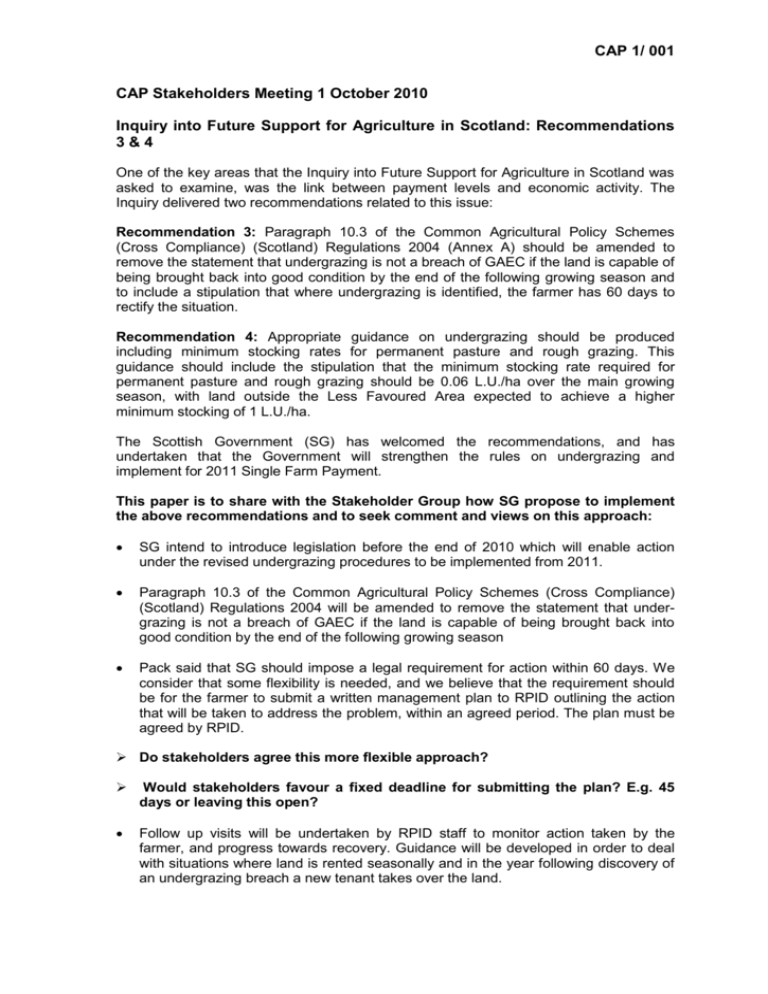
CAP 1/ 001 CAP Stakeholders Meeting 1 October 2010 Inquiry into Future Support for Agriculture in Scotland: Recommendations 3&4 One of the key areas that the Inquiry into Future Support for Agriculture in Scotland was asked to examine, was the link between payment levels and economic activity. The Inquiry delivered two recommendations related to this issue: Recommendation 3: Paragraph 10.3 of the Common Agricultural Policy Schemes (Cross Compliance) (Scotland) Regulations 2004 (Annex A) should be amended to remove the statement that undergrazing is not a breach of GAEC if the land is capable of being brought back into good condition by the end of the following growing season and to include a stipulation that where undergrazing is identified, the farmer has 60 days to rectify the situation. Recommendation 4: Appropriate guidance on undergrazing should be produced including minimum stocking rates for permanent pasture and rough grazing. This guidance should include the stipulation that the minimum stocking rate required for permanent pasture and rough grazing should be 0.06 L.U./ha over the main growing season, with land outside the Less Favoured Area expected to achieve a higher minimum stocking of 1 L.U./ha. The Scottish Government (SG) has welcomed the recommendations, and has undertaken that the Government will strengthen the rules on undergrazing and implement for 2011 Single Farm Payment. This paper is to share with the Stakeholder Group how SG propose to implement the above recommendations and to seek comment and views on this approach: SG intend to introduce legislation before the end of 2010 which will enable action under the revised undergrazing procedures to be implemented from 2011. Paragraph 10.3 of the Common Agricultural Policy Schemes (Cross Compliance) (Scotland) Regulations 2004 will be amended to remove the statement that undergrazing is not a breach of GAEC if the land is capable of being brought back into good condition by the end of the following growing season Pack said that SG should impose a legal requirement for action within 60 days. We consider that some flexibility is needed, and we believe that the requirement should be for the farmer to submit a written management plan to RPID outlining the action that will be taken to address the problem, within an agreed period. The plan must be agreed by RPID. Do stakeholders agree this more flexible approach? Would stakeholders favour a fixed deadline for submitting the plan? E.g. 45 days or leaving this open? Follow up visits will be undertaken by RPID staff to monitor action taken by the farmer, and progress towards recovery. Guidance will be developed in order to deal with situations where land is rented seasonally and in the year following discovery of an undergrazing breach a new tenant takes over the land. CAP 1/ 001 In the event of no action having been taken by the farmer or that the action taken is not in line with the agreed plan and there has been no improvement on the ground then penalties may be increased under the existing repetition and intentional procedures. A tolerance will be included in the guidance, to ensure that small pockets of undergrazed land including grass areas or margins within or around an arable crop area or common crofting arable area are not treated as breaches. Exceptions to the undergrazing conditions will be considered for land under active environmental management, or in the event of force majeure or exceptional circumstances. Pack suggested that stocking rates of 0.06 lu/ha and 1.0 lu/ha should be set out in guidance. This recognised that appropriate stocking rates vary depending on land quality and that it would not be appropriate to have stocking limits in the legislation. In order to avoid misleading applicants into assuming that they must stock at these levels it may be appropriate to simply require that grazing is appropriate to land quality in order to avoid undergrazing i.e. where the use of the land or the growth, structure or species composition of grazed vegetation is detrimental to the environmental and agricultural interest of the land.. Do stakeholders consider that we should include stocking rates in the guidance as a guideline for applicants? Or…. Should we instead state that land should be grazed at the appropriate level to avoid undergrazing and not propose that an absolute minimum stocking rate for either LFA or non LFA is set? RPID inspectors will assess whether land is being appropriately stocked based on visual assessment of the condition of the vegetation as per Paragraph 10.4 of the Common Agricultural Policy Schemes (Cross Compliance) (Scotland) Regulations 2004. They will also take account of factors including grazing management, stocking, quality and location of the land. Grazing management would normally relate to grazing by domestic livestock under the control of or with the consent of the Single Farm Payment claimant, but where active management of wild deer can be demonstrated then that could be taken into account by inspectors in assessing whether the land is being appropriately managed. Compliance ultimately would depend on the condition of the land and assessment of all the relevant factors. The presence of wild deer in itself would not be sufficient to demonstrate compliance with the requirements if land was considered to be undergrazed. Where vegetation is deemed to be in good agricultural and environmental condition at inspection no breach action will be taken. RPID will review risk selection criteria and weighting for land based inspections with a view to considering raising the risk score for businesses who have significantly increased the area claimed for single farm payment since 2005 and possibly for those who have significantly reduced livestock numbers without a corresponding reduction in area claimed. CAP 1/ 001 Where under-grazing is identified on a common grazing during an inspection, the action required will take account of all relevant circumstances including the number of shareholders, number of active shareholders who are utilising the common grazing, grazing regulations, souming. SG will also amend the cross compliance regulation where it refers to overgrazing: Paragraph 11.3 of the Common Agricultural Policy Schemes (Cross Compliance) (Scotland) Regulations 2004 will be amended to remove the statement that overgrazing is not a breach of GAEC if the land is capable of being brought back into good condition by the end of the following growing season Where over-grazing is identified on a common grazing during an inspection, the action required will take account of all relevant circumstances including the number of shareholders, number of active shareholders who are utilising the common grazing, grazing regulations, souming. Comments and views on the foregoing are welcome but particularly on the questions above in bold. CAP 1/ 001 ANNEX A Extract from SSI 2004/518- The Common Agricultural Policy Schemes (Cross- Compliance) (Scotland) Regulations 2004 PART IV Minimum level of maintenance and prevention of deterioration of habitats Minimum livestock stocking rates or/and appropriate regimes Undergrazing 10.—(1) A farmer must not allow undergrazing of land. (2) Where undergrazing under sub-paragraph (1) is identified by an authorised person, and the Scottish Ministers form the opinion that the land is undergrazed, the farmer must in addition comply with the conditions of any written management regime imposed by the Scottish Ministers in relation to that land; and the Scottish Ministers must pass or send a copy of that management regime to the farmer. (3) In establishing a non-compliance for the purposes of sub-paragraph (1), land is not undergrazed unless it is not capable of recovering to the extent that the use of the land or the growth, structure or species composition of grazed vegetation is no longer detrimental to the environmental or agricultural interest of the land by any time during the growing season in the calendar year following the date when the land first became undergrazed. (4) In this paragraph, “undergrazing” means not using land fully or scrub or coarse vegetation becoming evident, where the use of the land or the growth, structure or species composition of grazed vegetation is detrimental to the environmental or agricultural interest of the land. Overgrazing 11.—(1) Subject to sub-paragraph (2), a farmer must not allow overgrazing of land. (2) Where a farmer can demonstrate to the satisfaction of the Scottish Ministers that appropriate action has been taken, they will be taken to have complied with sub paragraph (1) where the overgrazing was caused by– (a) an incursion of geese which could not be predicted; (b) an incursion of wild deer which could not be predicted, where in the case of an incursion of significant numbers of such deer the farmer can show that advice has been taken from the Deer Commission for Scotland and that advice has been acted upon; or (c) rabbits, where the farmer can show that appropriate control methods have been used. (3) In establishing a non-compliance for the purposes of sub-paragraph (1), land is not overgrazed unless it is not capable of recovering to the extent that the growth quality or species composition of vegetation is no longer adversely affected to a significant degree by any time during the growing season in the calendar year following the date when the land first became overgrazed. (4) Where overgrazing under sub-paragraph (1) is identified by an authorised person, and the Scottish Ministers form the opinion that the land is overgrazed, the farmer must in addition comply with the conditions of any written management regime imposed by the Scottish Ministers in relation to that land; and the Scottish Ministers must pass or send a copy of that management regime to the farmer.
